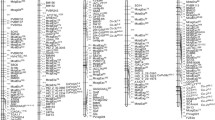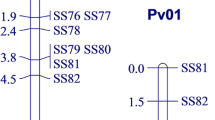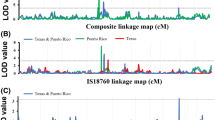Abstract
Resistance to nine races of the pathogenic fungus Colletotrichum lindemuthianum, causal agent of anthracnose, was evaluated in F3 families derived from the cross between the anthracnose differential bean cultivars TU (resistant to races, 3, 6, 7, 31, 38, 39, 102, and 449) and MDRK (resistant to races, 449, and 1545). Molecular marker analyses were carried out in the F2 individuals in order to map and characterize the anthracnose resistance genes or gene clusters present in these two differential cultivars. The results of the combined segregation indicate that at least three independent loci conferring resistance to anthracnose are present in TU. One of them, corresponding to the previously described anthracnose resistance locus Co-5, is located in linkage group B7, and is formed by a cluster of different genes conferring specific resistance to races, 3, 6, 7, 31, 38, 39, 102, and 449. Evidence of intra-cluster recombination between these specific resistance genes was found. The second locus present in TU confers specific resistance to races 31 and 102, and the third locus confers specific resistance to race 102, the location of these two loci remains unknown. The resistance to race 1545 present in MDRK is due to two independent dominant genes. The results of the combined segregation of two F4 families showing monogenic segregation for resistance to race 1545 indicates that one of these two genes is linked to marker OF10530, located in linkage group B1, and corresponds to the previously described anthracnose resistance locus Co-1. The second gene conferring resistance to race 1545 in MDRK is linked to marker Pv-ctt001, located in linkage group B4, and corresponds to the Co-3/Co-9 cluster. The resistance to race 449 present in MDRK is conferred by a single gene, located in linkage group B4, probably included in the same Co-3/Co-9 cluster.

Similar content being viewed by others
References
Adam-Blondon AF, Sévignac M, Bannerot H, Dron M (1994) SCAR, RAPD and RFLP markers linked to a dominant gene (Are) conferring resistance to anthracnose. Theor Appl Genet 88:865–870
Alzate-Marin AL, Baia GS, Junior TJP, Carbalho GA, Barros EG, Moreira MA (1997) Inheritance of anthracnose resistance in common bean differential cultivar AB136. Plant Dis 81:996–998
Alzate-Marin AL, Menarim H, de Carballo GA, de Paula Junior TJ, de Barros EG, Moreira MA (1999) Improved selection with newly RAPD markers linked to resistance gene to four pathotypes of Colletotrichum lindemuthianum in common bean. Phytopathology 89:281–285
Alzate-Marin AL, Costa MR, Arruda KM, Gonçalves de Barros E, Moreira MA (2003) Characterization of the anthracnose resistance gene present in Ouro Negro (Honduras 35) common bean cultivar. Euphytica 133:165–169
Alzate-Marin AL, Souza KA, Silva MGM, Oliveira EJ, Moreira MA, Barros EG (2007) Genetic characterization of anthracnose resistance genes Co-4 3 and Co-9 in common bean cultivar tlalneplantla 64 (PI207262). Euphytica 154:1–8
Awale HE, Kelly JD (2001) Development of SCAR markers linked to Co-4 2 gene in common bean. Annu Rep Bean Improv Coop 44:119–120
Balardin RS, Jarosz AM, Kelly JD (1997) Virulence and molecular diversity in Colletotrichum lindemuthianum from South, Central, and North America. Phytopathology 87:1184–1191
Bannerot H (1965) Résults de l’infection d’une collection de haricots par six races physiologiques d’anthracnose. Ann Amélior Plant (Paris) 15:201–222
Barrus MF (1915) An anthracnose-resistant red kidney bean. Phytopathology 5:303–311
Blair MW, Pedraza F, Buendia HF, Gaitán-Solís E, Beebe SE, Gepts P, Tohme J (2003) Development of a genome-wide anchored microsatellite map for common bean (Phaseolus vulgaris L.). Theor Appl Genet 107:1362–1374
Campa A (2006) Aplicación de marcadores moleculares en la gestión de la diversidad genética y en el análisis de la resistencia a antracnosis en judía. Ph. D. thesis, University of Oviedo, Spain
Campa A, Rodríguez-Suárez C, Pañeda A, Giraldez R, Ferreira JJ (2005) The bean anthracnose resistance gene Co-5 is located in linkage group B7. Annu Rep Bean Improv Coop 48:68–69
Campa A, Pérez Vega E, Giraldez R, Ferreira JJ (2007) Inheritance of race-specific resistance to anthracnose in the differential cultivar AB136. Annu Rep Bean Improv Coop 50:87–88
Cardenas F, Adams MW, Andersen A (1964) The genetic system for reaction of field beans (Phaseolus vulgaris L.) to infection by three physiologic races of Colletotrichum lindemuthianum. Euphytica 13:178–186
Creusot F, Macadré C, Ferrier-Cana E, Riou C, Geffroy V, Sévignac M, Dron M, Langin T (1999) Cloning and molecular characterization of three members of the NBS-LRR subfamily located in the vicinity of the Co-2 locus for anthracnose resistance in Phaseolus vulgaris. Genome 42:254–264
Ferreira JJ, Alvarez E, Fueyo MA, Roca A, Giraldez R (2000) Determination of the outcrossing rate of Phaseolus vulgaris L. using seed protein markers. Euphytica 113:259–263
Ferreira JJ, Campa A, Pérez-Vega E, Giraldez R (2008) Reaction of a bean germplasm collection against five races of Colletotrichum lindemuthianum identified in northern Spain and implications for breeding. Plant Dis 92:705–708
Ferrier-Cana E, Geffroy V, Macadré C, Creusot F, Imbert-Bolloré P, Sévignac M, Langin T (2003) Characterization of expressed NBS-LRR resistance gene candidates from common bean. Theor Appl Genet 106:251–261
Ferrier-Cana E, Macadré C, Sévignac M, David P, Langin T, Geffroy V (2005) Distinct post-transcriptional modifications result into seven alternative transcripts of the CC-NBS-LRR gene JA1tr of Phaseolus vulgaris. Theor Appl Genet 110:895–905
Fouilloux G (1976) L’anthracnose du haricot (Colletotrichum lindemuthianum, Sacc et Magn): nouvelles sources de résistance et nouvelles races physiologiques. Ann Amélior Plantes 26:443–453
Freyre R, Skroch PW, Geffroy V, Adam-Blondon AF, Shirmohamadali A, Johnson WC, Llaca V, Nodari RO, Pereira PA, Tsai SM, Tohme J, Dron M, Nienhuis J, Vallejos CE, Gepts P (1998) Towards an integrated linkage map of common bean. 4. Development of a core linkage map and alignment of RFLP maps. Theor Appl Gent 97:847–856
Geffroy V, Creusot F, Falquet J, Sévignac M, Adam-Blondon A-F, Bannerot H, Gepts P, Dron M (1998) A family of LRR sequences in the vicinity of the Co-2 locus for anthracnose resistance in Phaseolus vulgaris and its potential use in marker-assisted selection. Theor Appl Genet 96:494–502
Geffroy V, Sicard D, de Oliveira JCF, Sévignac M, Cohen S, Gepts P, Neema C, Langin T, Dron M (1999) Identification of an ancestral resistance gene cluster involved in the coevolution process between Phaseolus vulgaris and its fungal pathogen Colletotrichum lindemuthianum. Mol Plant Microbe Interact 12:774–784
Geffroy V, Sévignac M, Billant P, Dron M, Langin T (2008) Resistance to Colletotrichum lindemuthianum in Phaseolus vulgaris: a case study for mapping two independent genes. Theor Appl Genet 116:407–415
Gonçalves-Vidigal MC, Kelly JD (2006) Inheritance of anthracnose resistance in the common bean cultivar Widusa. Euphytica 151:411–419
Gonçalves-Vidigal MC, Sakiyama NS, Vidigal-Filho PS, Amaral-Junior AT, Poletine JP, Oliveira VR (2001) Resistance of common bean cultivar AB 136 to races 31 and 69 of Colletotrichum lindemuthianum: the Co-6 locus. Crop Breed Appl Biotechnol 1:99–104
Gonçalves-Vidigal MC, Silva CR, Filho PSV, Gonela A, Kvitschal MV (2007) Allelic relationships of anthracnose (Colletotrichum lindemuthianum) resistance in the common bean (Phaseolus vulgaris L.) cultivar Michelite and the proposal of a new anthracnose resistance gene, Co-11. Genet Mol Biol 30:589–593
Kelly JD, Vallejo VA (2004) A comprehensive review of the major genes conditioning resistance to anthracnose in common bean. HortScience 39:1196–1207
Kelly JD, Gepts P, Miklas PN, Coyne DP (2003) Tagging and mapping of genes and QTL and molecular marker-assisted selection for traits of economic importance in bean and cowpea. Field Crops Res 82:135–154
Lander ES, Green P, Abrahamson J, Barlow A, Daly MJ, Lincon SE, Newburgh L (1987) MAPMAKER: an interactive computing package for constructing primary genetic linkage maps of experimental and natural population. Genomics 1:174–181
Larsen RC, Miklas PN (2004) Generation and molecular mapping of a sequence characterized amplified region marker linked with the Bct gene for resistance to Beet curly top virus in common bean. Phytopathology 94:320–325
Mahuku GS, Riascos JJ (2004) Virulence and molecular diversity within Colletotrichum lindemuthianum isolates from Andean and Mesoamerican bean varieties and regions. Eur J Plant Pathol 110:253–263
Mastenbroek C (1960) A breeding programme for resistance to anthracnose in dry shell haricot beans, based on a new gene. Euphytica 9:177–184
Melotto M, Kelly JD (2000) An allelic series at the Co-1 locus conditioning resistance to anthracnose in common bean of Andean origin. Euphytica 116:143–149
Melotto M, Kelly JD (2001) Fine mapping of the Co-4 locus of common bean reveals a resistance gene candidate, COK-4, that encodes for a protein kinase. Theor Appl Genet 103:508–517
Melotto M, Balardin RS, Kelly JD (2000) Host-pathogen interaction and variability of Colletotrichum lindemuthianum. In: Prusky D, Freeman S, Dickman MB (eds) Colletotrichum host specificity, pathology, and host-pathogen interaction. APS Press, St. Paul, MN, pp 346–361
Melotto M, Coelho MF, Pedrosa-Harand A, Kelly JD, Camargo LEA (2004) The anthracnose resistance locus Co-4 of common bean is located on chromosome 3 and contains putative disease resistance-related genes. Theor Appl Genet 109:690–699
Méndez de Vigo B (2001) Mapa genético de Phaseolus vulgaris L. y resistencia a antracnosis en faba granja asturiana. Ph. D. thesis, University of Oviedo, Spain
Méndez-Vigo B, Rodríguez-Suárez C, Pañeda A, Ferreira JJ, Giraldez R (2005) Molecular markers and allelic relationships of anthracnose resistance gene cluster B4 in common bean. Euphytica 141:237–245
Menezes JR, Dianese JC (1988) Race characterization of Brazilian isolates of Colletotrichum lindemuthianum and detection of resistance to anthracnose in Phaseolus vulgaris L. Phytopathology 78:650–655
Miklas PN, Delorme R, Stone V, Daly MJ, Stavely JR, Steadman JR, Bassett MJ, Beaver JS (2000) Bacterial, fungal, and viral disease resistance loci mapped in a recombinant inbred common bean population (‘Dorado’/XAN 176). J Am Soc Hortic Sci 125:476–481
Muhalet CS, Adams MW, Saettler AW, Ghaderi A (1981) Genetic system for the reaction of field beans to beta, gamma, and delta races of Colletotrichum lindemuthianum. J Am Soc Hortic Sci 106:601–604
Pastor-Corrales MA (1991) Estandarización de variedades diferenciales y designación de razas de Colletotrichum lindemuthianum. Phytopathology 81:694
Queiroz VT, Sousa CS, Costa MR, Sanglad DA, Arruda KMA, Souza TLPO, Ragagnin VA, Barros EG, Moreira MA (2004) Development of SCAR markers linked to common bean anthracnose resistance genes Co-4 and Co-6. Annu Rep Bean Improv Coop 47:249–250
Rodríguez-Guerra R, Ramírez-Rueda MT, Martínez de la Vega O, Simpson J (2003) Variation in genotype, pathotype and anastomosis groups of Colletotrichum lindemuthianum isolates from Mexico. Plant Pathol 52:228–235
Rodríguez-Suárez C, Méndez-Vigo B, Pañeda A, Ferreira JJ, Giraldez R (2007) A genetic linkage map of Phaseolus vulgaris L. and localization of genes for specific resistance to six races of anthracnose (Colletotrichum lindemuthianum). Theor Appl Genet 114:713–722
Rodríguez-Suárez C, Ferreira JJ, Campa A, Pañeda A, Giraldez R (2008) Molecular mapping and intra-cluster recombination between anthracnose race-specific resistance genes in the common bean differential cultivars Mexico 222 and Widusa. Theor Appl Genet 116:807–814
Sicard D, Michalakis Y, Dron M, Neema C (1997) Genetic diversity and pathogenic variation of Colletotrichum lindemuthianum in the three centers of diversity of its host, Phaseolus vulgaris. Phytopathology 87:807–813
Vallejo V, Kelly JD (2001) Development of a SCAR marker linked to the Co-5 locus in common bean. Annu Rep Bean Improv Coop 44:121–122
Vallejo V, Kelly JD (2005) Unexpected resistance genes for anthracnose uncovered. Annu Rep Bean Improv Coop 48:74–75
Vallejo VA, Kelly JD (2008) Molecular tagging and genetic characterization of alleles at the Co-1 anthracnose resistance locus in common bean. ICFAI Univ J Genet Evol 1:7–20
van Schoonhoven A, Pastor-Corrales MA (1987) Standard system for the evaluation of bean germplasm. CIAT, Cali, Colombia
Young RA, Kelly JD (1996) Characterization of the genetic resistance to Colletotrichum lindemuthianum in common bean differential cultivars. Plant Dis 80:650–654
Young RA, Kelly JD (1997) RAPD markers linked to three major anthracnose resistance genes in common bean. Crop Sci 37:940–946
Young RA, Melotto M, Nodari RO, Kelly JD (1998) Marker-assisted dissection of the oligogenic anthracnose resistance in the common bean cultivar, ‘G2333’. Theor Appl Genet 96:87–94
Acknowledgments
This work was supported by grants AGL2004-08145-C02 and AGL2007-66563-C02 from the Ministerio de Educación y Ciencia, Spain. Ana Campa was recipient of a salary fellowship from the Instituto de Investigación y Tecnología Agraria y Alimentaria (INIA), Spain. Anthracnose races 7, 31, 39, 449, and 1545 were kindly provided by James D. Kelly (Michigan State University).
Author information
Authors and Affiliations
Corresponding author
Additional information
Communicated by D. Hoisington.
Electronic supplementary material
Below is the link to the electronic supplementary material.
Rights and permissions
About this article
Cite this article
Campa, A., Giraldez, R. & Ferreira, J.J. Genetic dissection of the resistance to nine anthracnose races in the common bean differential cultivars MDRK and TU. Theor Appl Genet 119, 1–11 (2009). https://doi.org/10.1007/s00122-009-1011-8
Received:
Accepted:
Published:
Issue Date:
DOI: https://doi.org/10.1007/s00122-009-1011-8




